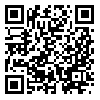Volume 25 - Supplementary
J Birjand Univ Med Sci. 2018, 25 - Supplementary: 46-52 |
Back to browse issues page
Download citation:
BibTeX | RIS | EndNote | Medlars | ProCite | Reference Manager | RefWorks
Send citation to:



BibTeX | RIS | EndNote | Medlars | ProCite | Reference Manager | RefWorks
Send citation to:
Ramazanzade K, Ebrahimzade A. Comparison of the Effect of Two Clinical Education Methods SNAPPS and conventional method on the medical students' clinical reasoning skills
. Journals of Birjand University of Medical Sciences 2018; 25 :46-52
URL: http://journal.bums.ac.ir/article-1-2454-en.html
URL: http://journal.bums.ac.ir/article-1-2454-en.html
1- Cardiovascular Diseases Research Center, Birjand University of Medical Sciences,Birjand,Iran
2- Infectious Disease Researches Center, Birjand University of Medical Sciences, Birjand, Iran ,mr14436@yahoo.com
2- Infectious Disease Researches Center, Birjand University of Medical Sciences, Birjand, Iran ,
Abstract: (8066 Views)
Background and Aim: Clinical reasoning is a major and essential skill for disease diagnosis which is necessary for all medical students, the snapps model as a student-centered model can provide the basis for clinical reasoning. The study aimed to compare the impact of the SNAPPS outpatient education model and the conventional method on medical students' clinical reasoning.
Clinical reasoning is a major and necessary skill for disease diagnosis learning the skill is both useful and necessary for medical students. The study aimed to compare the impact of the SNAPPS outpatient education model and the conventional method on medical students' clinical reasoning.
Materials and Methods: This is a quasi-experimental study with a control group and post-test. The population comprised of medical students in Birjand University of Medical Sciences who entered the infectious diseases ward in the 2015-16 academic year. The sample comprised of 126 students who were assigned into intervention and control groups via simple allocation method. The intervention group was trained with the SNAPPS model, while the matched controls – in terms of gender, education level, and GPA – were trained with the conventional outpatient education method. The clinical reasoning scores of the two groups were assessed using the KF test, and analyzed in SPSS-19 software using the independent t test.
Results: The results of this study showed that the clinical reasoning mean score in the intervention group(SNAPPS model) was 17.81 ± 1.20, and that of the control group(conventional method) was 16.85 ± 1.11, with the difference being statistically significant (P = 0.000).
Conclusion: The SNAPPS model is an effective model for developing students' clinical reasoning; therefore, application of this method is recommended for all courses in medical education.
Clinical reasoning is a major and necessary skill for disease diagnosis learning the skill is both useful and necessary for medical students. The study aimed to compare the impact of the SNAPPS outpatient education model and the conventional method on medical students' clinical reasoning.
Materials and Methods: This is a quasi-experimental study with a control group and post-test. The population comprised of medical students in Birjand University of Medical Sciences who entered the infectious diseases ward in the 2015-16 academic year. The sample comprised of 126 students who were assigned into intervention and control groups via simple allocation method. The intervention group was trained with the SNAPPS model, while the matched controls – in terms of gender, education level, and GPA – were trained with the conventional outpatient education method. The clinical reasoning scores of the two groups were assessed using the KF test, and analyzed in SPSS-19 software using the independent t test.
Results: The results of this study showed that the clinical reasoning mean score in the intervention group(SNAPPS model) was 17.81 ± 1.20, and that of the control group(conventional method) was 16.85 ± 1.11, with the difference being statistically significant (P = 0.000).
Conclusion: The SNAPPS model is an effective model for developing students' clinical reasoning; therefore, application of this method is recommended for all courses in medical education.
Type of Study: Original Article |
Subject:
Medical Education
Received: 2018/02/18 | Accepted: 2018/05/16 | ePublished: 2018/09/5
Received: 2018/02/18 | Accepted: 2018/05/16 | ePublished: 2018/09/5
Send email to the article author
| Rights and permissions | |
 |
This work is licensed under a Creative Commons Attribution-NonCommercial 4.0 International License. |






